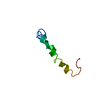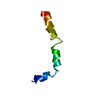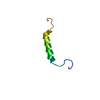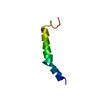+ Open data
Open data
- Basic information
Basic information
| Entry | Database: PDB / ID: 1kx6 | ||||||
|---|---|---|---|---|---|---|---|
| Title | NMR solution structure of Glucagon in a lipid-water interphase | ||||||
 Components Components | Glucagon | ||||||
 Keywords Keywords | HORMONE/GROWTH FACTOR /  hormone / HORMONE-GROWTH FACTOR COMPLEX hormone / HORMONE-GROWTH FACTOR COMPLEX | ||||||
| Function / homology |  Function and homology information Function and homology informationGlucagon signaling in metabolic regulation / Synthesis, secretion, and deacylation of Ghrelin /  glucagon receptor binding / Synthesis, secretion, and inactivation of Glucagon-like Peptide-1 (GLP-1) / : / lactate biosynthetic process / negative regulation of execution phase of apoptosis / Glucagon-type ligand receptors / G alpha (s) signalling events / G alpha (q) signalling events ...Glucagon signaling in metabolic regulation / Synthesis, secretion, and deacylation of Ghrelin / glucagon receptor binding / Synthesis, secretion, and inactivation of Glucagon-like Peptide-1 (GLP-1) / : / lactate biosynthetic process / negative regulation of execution phase of apoptosis / Glucagon-type ligand receptors / G alpha (s) signalling events / G alpha (q) signalling events ...Glucagon signaling in metabolic regulation / Synthesis, secretion, and deacylation of Ghrelin /  glucagon receptor binding / Synthesis, secretion, and inactivation of Glucagon-like Peptide-1 (GLP-1) / : / lactate biosynthetic process / negative regulation of execution phase of apoptosis / Glucagon-type ligand receptors / G alpha (s) signalling events / G alpha (q) signalling events / lipid biosynthetic process / Glucagon-like Peptide-1 (GLP1) regulates insulin secretion / positive regulation of calcium ion import / positive regulation of insulin secretion involved in cellular response to glucose stimulus / regulation of insulin secretion / positive regulation of protein kinase activity / positive regulation of gluconeogenesis / protein kinase A signaling / response to activity / positive regulation of peptidyl-threonine phosphorylation / adenylate cyclase-modulating G protein-coupled receptor signaling pathway / adenylate cyclase-activating G protein-coupled receptor signaling pathway / glucagon receptor binding / Synthesis, secretion, and inactivation of Glucagon-like Peptide-1 (GLP-1) / : / lactate biosynthetic process / negative regulation of execution phase of apoptosis / Glucagon-type ligand receptors / G alpha (s) signalling events / G alpha (q) signalling events / lipid biosynthetic process / Glucagon-like Peptide-1 (GLP1) regulates insulin secretion / positive regulation of calcium ion import / positive regulation of insulin secretion involved in cellular response to glucose stimulus / regulation of insulin secretion / positive regulation of protein kinase activity / positive regulation of gluconeogenesis / protein kinase A signaling / response to activity / positive regulation of peptidyl-threonine phosphorylation / adenylate cyclase-modulating G protein-coupled receptor signaling pathway / adenylate cyclase-activating G protein-coupled receptor signaling pathway /  hormone activity / positive regulation of protein binding / positive regulation of peptidyl-serine phosphorylation / hormone activity / positive regulation of protein binding / positive regulation of peptidyl-serine phosphorylation /  glucose homeostasis / positive regulation of ERK1 and ERK2 cascade / negative regulation of apoptotic process / glucose homeostasis / positive regulation of ERK1 and ERK2 cascade / negative regulation of apoptotic process /  extracellular space / identical protein binding / extracellular space / identical protein binding /  cytoplasm cytoplasmSimilarity search - Function | ||||||
| Method |  SOLUTION NMR / torsion angle dynamics SOLUTION NMR / torsion angle dynamics | ||||||
 Authors Authors | Braun, W. / Wider, G. / Lee, K.H. / Wuthrich, K. | ||||||
 Citation Citation |  Journal: J.Mol.Biol. / Year: 1983 Journal: J.Mol.Biol. / Year: 1983Title: Conformation of glucagon in a lipid-water interphase by 1H nuclear magnetic resonance. Authors: Braun, W. / Wider, G. / Lee, K.H. / Wuthrich, K. | ||||||
| History |
|
- Structure visualization
Structure visualization
| Structure viewer | Molecule:  Molmil Molmil Jmol/JSmol Jmol/JSmol |
|---|
- Downloads & links
Downloads & links
- Download
Download
| PDBx/mmCIF format |  1kx6.cif.gz 1kx6.cif.gz | 191.6 KB | Display |  PDBx/mmCIF format PDBx/mmCIF format |
|---|---|---|---|---|
| PDB format |  pdb1kx6.ent.gz pdb1kx6.ent.gz | 157.2 KB | Display |  PDB format PDB format |
| PDBx/mmJSON format |  1kx6.json.gz 1kx6.json.gz | Tree view |  PDBx/mmJSON format PDBx/mmJSON format | |
| Others |  Other downloads Other downloads |
-Validation report
| Arichive directory |  https://data.pdbj.org/pub/pdb/validation_reports/kx/1kx6 https://data.pdbj.org/pub/pdb/validation_reports/kx/1kx6 ftp://data.pdbj.org/pub/pdb/validation_reports/kx/1kx6 ftp://data.pdbj.org/pub/pdb/validation_reports/kx/1kx6 | HTTPS FTP |
|---|
-Related structure data
| Similar structure data |
|---|
- Links
Links
- Assembly
Assembly
| Deposited unit | 
| |||||||||
|---|---|---|---|---|---|---|---|---|---|---|
| 1 |
| |||||||||
| NMR ensembles |
|
- Components
Components
| #1: Protein/peptide |  Mass: 3486.781 Da / Num. of mol.: 1 / Source method: obtained synthetically Details: This protein was chemically synthesized. It is naturally found in Bos taurus (Bovine). References: UniProt: P01272 |
|---|
-Experimental details
-Experiment
| Experiment | Method:  SOLUTION NMR SOLUTION NMR | ||||||||||||
|---|---|---|---|---|---|---|---|---|---|---|---|---|---|
| NMR experiment |
| ||||||||||||
| NMR details | Text: This structure was determined using standard 2D homonuclear techniques. |
- Sample preparation
Sample preparation
| Details |
| |||||||||
|---|---|---|---|---|---|---|---|---|---|---|
| Sample conditions | Ionic strength: 50 mM phosphate Na / pH: 6.0 / Pressure: ambient / Temperature: 310 K |
-NMR measurement
| Radiation | Protocol: SINGLE WAVELENGTH / Monochromatic (M) / Laue (L): M |
|---|---|
| Radiation wavelength | Relative weight: 1 |
| NMR spectrometer | Type: Bruker WM / Manufacturer: Bruker / Model : WM / Field strength: 500 MHz : WM / Field strength: 500 MHz |
- Processing
Processing
| NMR software |
| ||||||||||||
|---|---|---|---|---|---|---|---|---|---|---|---|---|---|
| Refinement | Method: torsion angle dynamics / Software ordinal: 1 | ||||||||||||
| NMR representative | Selection criteria: minimal target function | ||||||||||||
| NMR ensemble | Conformer selection criteria: target function / Conformers calculated total number: 100 / Conformers submitted total number: 20 |
 Movie
Movie Controller
Controller











 PDBj
PDBj



